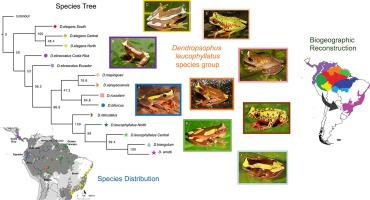Molecular Phylogenetics and Evolution ( IF 3.6 ) Pub Date : 2020-06-06 , DOI: 10.1016/j.ympev.2020.106877 Renata M Pirani 1 , Pedro L V Peloso 2 , Joyce R Prado 3 , Érico M Polo 4 , L Lacey Knowles 5 , Santiago R Ron 6 , Miguel T Rodrigues 7 , Marcelo J Sturaro 8 , Fernanda P Werneck 9

|
General consensus emphasizes that no single biological process can explain the patterns of species’ distributions and diversification in the Neotropics. Instead, the interplay of several processes across space and time must be taken into account. Here we investigated the phylogenetic relationships and biogeographic history of tree frogs in the Dendropsophus leucophyllatus species group (Amphibia: Hylidae), which is distributed across Amazonia and the Atlantic rainforests. Using Next Generation Sequencing (NGS) and double digest restriction-site associated DNA (ddRADseq), we inferred phylogenetic relationships, species limits, and temporal and geographic patterns of diversification relative to the history of these biomes. Our results indicate that the D. leucophyllatus species group includes at least 14 independent lineages, which are currently arranged into ten described species. Therefore, a significant portion of species in the group are still unnamed. Different processes were associated to the group diversification history. For instance, the Andes uplift likely caused allopatric speciation for Cis-Andean species, whereas it may also be responsible for changes in the Amazonian landscape triggering parapatric speciation by local adaptation to ecological factors. Meanwhile, Atlantic Forest ancestors unable to cross the dry diagonal biomes after rainforest’s retraction, evolved in isolation into different species. Diversification in the group began in the early Miocene, when connections between Atlantic Forest and the Andes (Pacific Dominion) by way of a south corridor were possible. The historical scenario in Amazonia, characterized by several speciation events and habitat heterogeneity, helped promoting diversification, resulting in the highest species diversity for the group. This marked species diversification did not happen in Atlantic Forest, where speciation is very recent (late Pliocene and Pleistocene), despite its remarkable climatic heterogeneity.
中文翻译:

新热带雨林中的小丑树蛙的多样化历史(阿努拉(Anura),鬣狗科(Hylidae),登露兜帽leucophyllatus组)。
普遍共识强调,没有任何生物过程可以解释新热带地区物种分布和多样化的模式。相反,必须考虑跨空间和时间的多个过程的相互作用。在这里,我们调查了分布在亚马逊河和大西洋雨林中的树蛙(Dendropsophus leucophyllatus物种组(两栖动物:Hylidae))中树蛙的系统发生关系和生物地理历史。使用下一代测序(NGS)和双酶切限制性位点相关的DNA(ddRADseq),我们可以推断出与这些生物群落历史相关的系统发育关系,物种限制以及时间和地理分布的多样化。我们的结果表明,D.leucophyllatus物种组包括至少14个独立谱系,目前被划分为10个所述物种。因此,该物种中很大一部分物种仍未命名。不同的过程与群体多元化的历史有关。例如,安第斯山脉的隆升很可能引起了顺地斯-安第斯物种的异源物种形成,而它也可能是由于当地对生态因素的适应而触发了亚马孙地区景观的变化,从而引发了异族物种的形成。同时,在雨林退缩后,大西洋森林的祖先无法越过干燥的对角线生物群落,孤立地演变成不同的物种。该组的多样化始于中新世早期,当时可能通过南走廊将大西洋森林与安第斯山脉(太平洋领地)联系起来。以几个物种形成事件和栖息地异质性为特征的亚马逊地区的历史情景有助于促进多样化,从而使该物种的物种多样性最高。尽管具有明显的气候异质性,但大西洋沿岸地区的物种多样性并没有发生(近上新世和更新世晚期),但这种物种的多样性并没有发生。











































 京公网安备 11010802027423号
京公网安备 11010802027423号